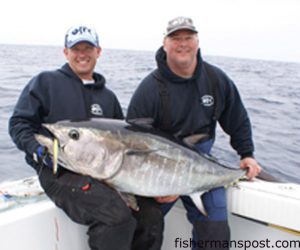Dusting Off the Cobwebs

Capt. Barrett McMullan and Brian Aycock with a 57″ bluefin tuna that they landed while vertical jigging near the Point. The fish bit a 240 gram gold/black jig and was landed using 80# braid on a Shimano Stella 18000/Star Plasma combo. The duo were fishing with Capt. Brant McMullan, Derek Treffinger and Rickey Beck aboard the “Team OIFC” 32â Yellowfin.
It’s been a long and cold couple of months. Fishing has taken a backseat to bottom paint, oil changes, trailer maintenance… all that “fun” stuff. However, April is within sight, and thus my inner fisherman is becoming restless.
For the past two years, I’ve taken a trip up to Oregon Inlet to partake in an incredible bluefin tuna fishery that comes together during the months of February and March. Whether these fish have been there all along or something changed to bring them in, this is by far the largest congregation of bluefin tuna on the East coast. The bluefin come together near the “Point,” halfway between Hatteras and Oregon Inlet, providing an awesome opportunity to do battle with the ocean’s most powerful fish.
Every fishing trip is a learning opportunity, but I also consider this bluefin fishery an excellent opportunity to dust off the cobwebs and get my gear, my body, and my mind prepared for the season of fishing ahead.
The two previous years we would roll out of Oregon Inlet, fill our livewell with 3-5 pound bluefish, run to an area near the “Point,” and basically hand-feed bluefin tuna. The first year the fish were in the 50-65 inch range, last year they were 65-80 inches, and this year they obviously had not been skipping meals.
We cleared Oregon Inlet at 6:15 am behind the parade of 60’ boats, but quickly pulled out of line as we sought to do our “own” thing (something we often do that produces our typical “checkers or wreckers” results). Unfortunately, the wreckers were on stand by as our usual bait spots this year were a frigid 42 degrees.
We headed offshore to locate the fleet and the fish, resorting to an arsenal of rigged ballyhoo, jigs, and poppers. The scene was typical, with boats scattered over a three mile area, most trolling and many hooked up. We deployed a spread of trolled ballyhoo, two up top and two down deep on planers.
The bluefin were marking in 150’-200’, but we couldn’t buy a bite. A look around proved what is too often the case: the diesel boats had bent rods, and the outboards were left as spectators.
By 11:00 am, we had watched all we could stand and pulled out the jigging gear. I will profess that jigging is a technique that I use only as a last resort, and thus I have not spent much money on gear nor much time on perfecting technique. My crew prepared themselves with jigs as I rode around listening for the Wicked Tuna “beep, beep, beep” from my sounder.
“There they are boys, 150’-170’ down, drop them now.”
I gave the word but was less than optimistic. However, I was quickly proven wrong as we hooked up within minutes.
And this is when the lesson portion of the fishing trip begins. A bluefin tuna will expose any weakness in your fishing gear: rod, reel, line, splices, knots… if it is weak, they will break it.
The first lesson is that your leader needs to be at least 130 lb. test; 80 lbs. broke at the jig or within a couple feet of it on every hook up. Second, you had better be using at least 80 lb. braid, and you will need a couple hundred yards of capacity. Last, if you “cheaped” out on your rod or reel, you will be headed back to the tackle store to replace the one you are now carrying in two hands.
The good news is I feel much more confident in my ability to produce bites with jigs. The bad news is all but one of the nine bites led to a break off. We lucked up and hooked a 57” pup, which made for a nice dinner table treat, but all the rest of the bites were from much larger fish that had no problem in teaching us all the things we were doing wrong.
And thus another year of Oregon Inlet bluefin fishing is in the books for Team OIFC. It was a great time with family, and our pelagic friends offered up some humble pie and an opportunity to learn for future fishing adventures.
As is always our motto and once again true with this adventure: patience, persistence, and unrelenting commitment to accomplishment of the objective.
